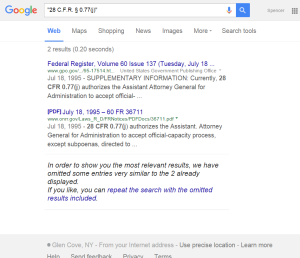I’m writing this post because it was something I had to dig into. In a lawsuit in a federal court, where you are suing an agency, corporation, officer or employee of the United States, the steps to follow to properly serve the governmental agency, corporation, officer or employee can be complicated. It’s easy to miss one of the steps and have your case dismissed. No plaintiff wants that.
Service of Process Upon the U.S. Attorney General as Required Under FRCP 4(i)(1)(B)
The instructions are contained at Rule 4(i) of the Federal Rules of Civil Procedure (“FRCP”). Let’s take an example and that one of the defendants is the Secretary of the Department of Housing and Urban Development (“HUD”).
Rule 4(i)(2) requires that to serve the HUD Secretary, you must “serve the United States and also send a copy of the summons and of the complaint by registered or certified mail to the agency, corporation, officer, or employee.”
So Rule 4(i)(2) sends you right back to Rule 4(i)(1).
Rule 4(i)(1) has two steps to effect service (provided you’re not challenging an order of a nonparty agency or officer of the U.S.):
Step 1 (choose one of the following)
(a) Deliver a copy of the summons and complaint to the U.S. Attorney in the district where the action is brought or
(b) Send a copy of the summons and complaint to the civil-process clerk at the office of the U.S. Attorney.
Step 2
Send a copy of the summons and complaint by registered or certified mail to the U.S. Attorney General at Washington, D.C.
Back to the example. To serve the HUD Secretary, choose either (a) or (b) from Step 1 and then carry out Step 2.
Service of Process Upon U.S. Attorney General Pursuant to Rule 4(i)(2)
Things get tricky when one of your defendants is the Attorney General of the United States. A reading of Rule 4 would seem to mean that if the U.S. Attorney General is a defendant in his or her official capacity, you would technically have to serve the Attorney General twice!
Playing this out, say I want to sue Loretta Lynch, Attorney General, in her official capacity. I follow Rule 4(i)(1)(A) and then choose one of the options from Step 1 and then carry out Step 2. Step 2 requires me to send a copy of the summons and complaint via registered or certified mail to the Attorney General at Washington, D.C.
It would seem redundant then to have to serve the Attorney General pursuant to Rule 4(i)(2) since I already sent a copy of the documents to the Attorney General by following Rule 4(i)(B). However, it’s not worth taking a risk of your case being dismissed for improper service so you should also serve the Attorney General of the U.S. according to Rule 4(i)(2).
What is the Justice Management Division and Who is the Assistant Attorney General for Administration?
But how do you serve the Attorney General of the U.S. according to Rule 4(i)(2)? Browsing the web for commentary or instructions on this didn’t produce much. Here’s the first page of the Google results:

The first result is a link to Title 4, Section 2.000, of the U.S. Attorney’s Manual (“4-2.000 – Instituting Action”). Like breadcrumbs, I follow where this leads and scroll down to “4-2.300 – Service of Process.”
The second paragraph reads:
The Attorney General has designated the Assistant Attorney General for Administration, Justice Management Division, to accept service of summonses and complaints for him/her. See 28 C.F.R. § 0.77(j). United States Attorneys have no authority to accept service on behalf of the Attorney General.
Next, I go find 28 C.F.R. § 0.77(j). To give an idea of how deep this section is buried, you have to go to Title 28 (Judicial Administration) of the Code of Federal Regulations (“CFR”), Chapter 1, Part 0, Subpart O (Justice Management Division) and then section 0.77 entitled “Operational functions.” This section states:
The Assistant Attorney General for Administration shall provide all direct administrative support services to the Offices, Boards and Divisions of the Department and to the U.S. Marshals Service, except where independent administrative authority has been conferred. These services shall include the following:
(j) Accepting service of summonses, complaints, or other papers, including, without limitation, subpoenas, directed to the Attorney General in his official capacity, as a representative of the Attorney General, under the Federal Rules of Civil and Criminal Procedure or in any suit within the purview of subsection (a) of section 208 of the Department of Justice Appropriation Act, 1953 (66 Stat. 560 (43 U.S.C. 666(a))).
Why, in searching endlessly for commentary or case law where for issues of service of process where the Attorney General of the United States, is a named party to an action in his or her official capacity, had I never heard of this obscure rule or even the terms “Justice Management Division” or “Assistant Attorney General for Administration”? Was it because everyone just knows this rule from law school?
Rule 4(i)(1)(B), according to Judge Easterbrook of the Seventh Circuit Court of Appeals, ” is designed to help the Department of Justice monitor its field offices and maintain a central register of litigation.” Tuke v. United States, 76 F.3d 155, 157 (1996).
Why did a google search for “28 C.F.R. § 0.77(j)” come back virtually empty?

Removing the quotes gets more hits but nothing related to analysis or case law. By the second page, the results become random and totally irrelevant. I then changed my search terms and the following is the result:

Now I’m puzzled. There’s been a lot of case law discussing compliance with Rule 4(i)(1)(B). McMasters v. US, 260 F.3d 814 (7th Cir. 2001); Townsend v. Public Storage, Inc., No. 1: 13-cv-01600 (TJM/TWD) (N.D.N.Y. Apr. 30, 2014). But that’s not what I was looking for. I wanted to find where a plaintiff effected service on the Attorney General of the United States, in his or her official capacity, as a defendant, pursuant with Rule 4(i)(2).
In a decision in the case, Mercedes v. Holder, the judge stated that the plaintiff “served the officers and employees of the United States who are named defendants in this action, including the Attorney General.” Taking a look at that affidavit of service, service was addressed to “Eric Holder, Attorney General, U.S. Dept. of Justice, 950 Pennsylvania Ave., NW, Washington, D.C. 20530.”
For some reason, the government never contested the judge’s determination that service of process upon the Attorney General – pursuant to Rule 4(i)(2) and NOT Rule 4(i)(1)(B) – was not mailed to Assistant Attorney General for Administration.
Conclusion with Step-by-Step Instructions for Service of Process on United States Attorney General as a Defendant in Official Capacity
To conclude, and what you should take away from this post which has gotten too long, is that in any case where the United States Attorney General is sued in his or her official capacity, here is what you must do:
Step 1 (choose one of the following)
(a) Deliver a copy of the summons and complaint to the U.S. Attorney in the district where the action is brought or
(b) Send a copy of the summons and complaint to the civil-process clerk at the office of the U.S. Attorney.
Step 2
Send a copy of the summons and complaint by registered or certified mail to the U.S. Attorney General at Washington, D.C. While the address for the U.S. Attorney General is usually stated as 950 Pennsylvania Ave., NW, Washington, D.C. 20530, I would literally just write on the label “U.S. Attorney General, Washington, DC 20530.”
Step 3
Send a copy of the summons and complaint by registered or certified mail to:
Assistant Attorney General for Administration
U.S. Department of Justice
Justice Management Division
950 Pennsylvania Avenue, NW
Room 1111
Washington, DC 20530
Conclusions
When the U.S. Attorney General is sued in his or her in their official capacity as a defendant, you will basically be providing the U.S. A.G. two sets of the summons and complaint. The first set is in connection with the service requirements of Rule 4(i)(2) which require the Attorney General’s office be provided the summons and complaint in accordance with Rule 4(i)(1)(B). The second set is because you also have to comply with Rule 4(i)(2). While it may be tempting to just think, “Well, the Attorney General’s office already has my summons and complaint, I don’t think I need to send them another copy,” this is the attitude which will get your case dismissed by a detail-oriented and aggressive U.S. Attorney. Though I’ve never seen a U.S. Attorney raise the fact that service was not properly effected by not being mailed to the address for the Assistant Attorney General for Administration, I don’t want to be the first person this argument is used against. It’s better to be safe than sorry and follow the explicit rules and instructions, to the letter.

